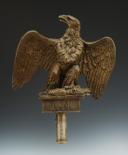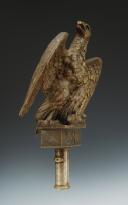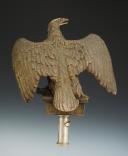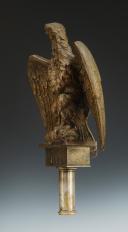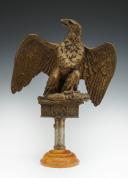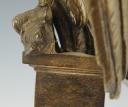
FLAG EAGLE OF THE NATIONAL GUARD, model 1852, Presidency of Louis-Napoleon. 25919
Sold out
FLAG EAGLE OF THE NATIONAL GUARD, model 1852, Presidency of Louis-Napoleon. 25919
Silvered bronze eagle in accordance with regulations. It represents the uncrowned imperial eagle with outstretched wings holding the sparkling spindle of Jupiter in its claws, placed on a pedestal, its head turned to the right. It is cast and stamped according to the parts, it consists of nine welded parts: body face, body back, right body side, right wing face, right wing back, left wing face, left wing back, left claws, lower tail part. Cast copper box bearing “L. N.” on the obverse, the reverse has no inscription.
The upper molding of the box is stamped “M.A. MARION” on its right side, and on its left side it is stamped “A. BARRE F CIT”.
Silver-plated bronze socket onto which is screwed a raised ring tab intended to screw in the hook to hang the tie.
The eagle is presented on a wooden base.
Dimensions:
Eagle and upper molding of the box: H 21 cm, width 25.5 cm, depth approximately 8.5 cm.
Lower part of the box: H 3.2 cm, width 9.7 cm, depth 4.3 cm.
“L.N. »: H 2.4 cm.
Socket: diameter 3.3 cm, diameter at the lower molding 3.3 cm, H 8.2 cm.
Total height: 32.5 cm.
Weight: 2.5 kg.
France.
Presidency of Louis Napoleon.
Good condition, silvering present but partly rubbed, some very light dents, a dent on the eagle's chest.
KNOWN EXAMPLES:
This eagle is of the greatest rarity, it is the only one currently known in silvered bronze in accordance with the regulations. The rear of the box has no decoration or inscription, this first model having been quickly modified, it is probable that for the provincial national guards, the boxes remained just with the initials LN on the front part.
Eagle of the 34th battalion of the Seine, collection of the Army Museum, inventory number 04495; 24 MOK; BD 235.1. In gilded bronze.
Eagle of the 24th battalion of the Seine which bears on the box: “LN/SEINE/24”, offered on this site a few years ago (see archives). In gilded bronze.
HISTORY: On December 31, 1851, President Louis-Napoléon ordered the reinstatement of the French eagle on army flags. On March 4, 1852, the artillery management sent to the Minister of War, for approval, a type of eagle executed and proposed by Auguste Barre, sculptor. The first market provides for large model eagles for flags and small models for standards. Finally, only the large model is retained. In July 1852, Marion executed a first model for the 109 eagles to surmount the flags and standards of the battalions and squadrons of the National Guard. These eagles, with a design very different from that of the army eagles, have their heads turned to the right and are silver. On the box, on the obverse, the letters "L N" and on the reverse the name of the department with, below, the number of the battalion or squadron. The Army Museum keeps the typical plaster model and the eagle of the 24th battalion of the Seine which bears on the box: “LN/SEINE/24”. Contrary to the regulations, this eagle is golden. These eagles were handed over on August 15, 1852. Intended primarily for maintaining order, the national guard was made up almost entirely of infantry. Each battalion has a flag-bearer second lieutenant. In July 1852, the flags of the National Guard were ordered from Marion, namely: 52 flags for the Seine battalions and 2 standards (Paris cavalry legion and suburban squadron), 54 flags and one standard for the battalions of province, figure subsequently increased. For the National Guard the flag is that of the 1852 line model, with in each corner and on both sides a golden laurel wreath surrounding the letters "L N". Mid-fine silver fringe. For the making of these flags, the minister sent Marion 250 new flags dating from 1848 with one usable blank side, the other side bearing FRENCH REPUBLIC LIBERTY EQUALITY FRATERNITY. Marion also uses the shafts and fringes which he had to silver because they were golden. The inscriptions on these flags follow the following requirements:
a) Cities in which only one battalion is organized. Obverse: NATIONAL GUARD OF (city name). Reverse: DEPARTMENT OF
b) Cities in which more than one battalion is organized. Obverse: BATTALION CITY NO. Reverse: NATIONAL GUARD OF (name of department)
c) Special weapons. Obverse: CITY OF FIREFIGHTERS BATTALION or GUNNERS. Reverse: NATIONAL GUARD OF (name of department)
d) The above regulation is not followed for the Seine department. The emblems were presented on August 15, 1852.
Obverse: NATIONAL GUARDS/OF THE/SEINE. Reverse: battalion number. Model of the standards: Obverse: LOUIS-NAPOLEON/A LA/LEGION OF CAVALERIE/OF/PARIS. Reverse: NATIONAL GUARDS/DE LA/SEINE. Note that the 1st suburban battalion following the 22nd Paris battalion took the number 23 and so on. The making of these flags, which began in July 1852, continued until the end of 1853.
Silvered bronze eagle in accordance with regulations. It represents the uncrowned imperial eagle with outstretched wings holding the sparkling spindle of Jupiter in its claws, placed on a pedestal, its head turned to the right. It is cast and stamped according to the parts, it consists of nine welded parts: body face, body back, right body side, right wing face, right wing back, left wing face, left wing back, left claws, lower tail part. Cast copper box bearing “L. N.” on the obverse, the reverse has no inscription.
The upper molding of the box is stamped “M.A. MARION” on its right side, and on its left side it is stamped “A. BARRE F CIT”.
Silver-plated bronze socket onto which is screwed a raised ring tab intended to screw in the hook to hang the tie.
The eagle is presented on a wooden base.
Dimensions:
Eagle and upper molding of the box: H 21 cm, width 25.5 cm, depth approximately 8.5 cm.
Lower part of the box: H 3.2 cm, width 9.7 cm, depth 4.3 cm.
“L.N. »: H 2.4 cm.
Socket: diameter 3.3 cm, diameter at the lower molding 3.3 cm, H 8.2 cm.
Total height: 32.5 cm.
Weight: 2.5 kg.
France.
Presidency of Louis Napoleon.
Good condition, silvering present but partly rubbed, some very light dents, a dent on the eagle's chest.
KNOWN EXAMPLES:
This eagle is of the greatest rarity, it is the only one currently known in silvered bronze in accordance with the regulations. The rear of the box has no decoration or inscription, this first model having been quickly modified, it is probable that for the provincial national guards, the boxes remained just with the initials LN on the front part.
Eagle of the 34th battalion of the Seine, collection of the Army Museum, inventory number 04495; 24 MOK; BD 235.1. In gilded bronze.
Eagle of the 24th battalion of the Seine which bears on the box: “LN/SEINE/24”, offered on this site a few years ago (see archives). In gilded bronze.
HISTORY: On December 31, 1851, President Louis-Napoléon ordered the reinstatement of the French eagle on army flags. On March 4, 1852, the artillery management sent to the Minister of War, for approval, a type of eagle executed and proposed by Auguste Barre, sculptor. The first market provides for large model eagles for flags and small models for standards. Finally, only the large model is retained. In July 1852, Marion executed a first model for the 109 eagles to surmount the flags and standards of the battalions and squadrons of the National Guard. These eagles, with a design very different from that of the army eagles, have their heads turned to the right and are silver. On the box, on the obverse, the letters "L N" and on the reverse the name of the department with, below, the number of the battalion or squadron. The Army Museum keeps the typical plaster model and the eagle of the 24th battalion of the Seine which bears on the box: “LN/SEINE/24”. Contrary to the regulations, this eagle is golden. These eagles were handed over on August 15, 1852. Intended primarily for maintaining order, the national guard was made up almost entirely of infantry. Each battalion has a flag-bearer second lieutenant. In July 1852, the flags of the National Guard were ordered from Marion, namely: 52 flags for the Seine battalions and 2 standards (Paris cavalry legion and suburban squadron), 54 flags and one standard for the battalions of province, figure subsequently increased. For the National Guard the flag is that of the 1852 line model, with in each corner and on both sides a golden laurel wreath surrounding the letters "L N". Mid-fine silver fringe. For the making of these flags, the minister sent Marion 250 new flags dating from 1848 with one usable blank side, the other side bearing FRENCH REPUBLIC LIBERTY EQUALITY FRATERNITY. Marion also uses the shafts and fringes which he had to silver because they were golden. The inscriptions on these flags follow the following requirements:
a) Cities in which only one battalion is organized. Obverse: NATIONAL GUARD OF (city name). Reverse: DEPARTMENT OF
b) Cities in which more than one battalion is organized. Obverse: BATTALION CITY NO. Reverse: NATIONAL GUARD OF (name of department)
c) Special weapons. Obverse: CITY OF FIREFIGHTERS BATTALION or GUNNERS. Reverse: NATIONAL GUARD OF (name of department)
d) The above regulation is not followed for the Seine department. The emblems were presented on August 15, 1852.
Obverse: NATIONAL GUARDS/OF THE/SEINE. Reverse: battalion number. Model of the standards: Obverse: LOUIS-NAPOLEON/A LA/LEGION OF CAVALERIE/OF/PARIS. Reverse: NATIONAL GUARDS/DE LA/SEINE. Note that the 1st suburban battalion following the 22nd Paris battalion took the number 23 and so on. The making of these flags, which began in July 1852, continued until the end of 1853.
Reference :
25919 inst
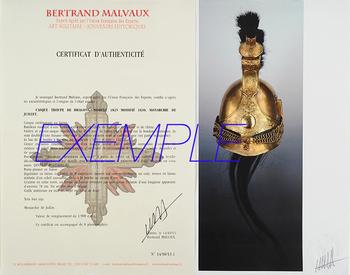
Next update Friday, april 4th at 1:30 PM
FOR ALL PURCHASES, PAYMENT IN MULTIPLE CHECKS POSSIBLE
bertrand.malvaux@wanadoo.fr 06 07 75 74 63
An authenticity certificate of the item including the description published on the site, the period, the sale price, accompanied by one or more color photographs is automatically provided for any item priced over 130 euros. Below this price, each certificate is charged 5 euros.
Only items sold by me are subject to an authenticity certificate, I do not provide any expert reports for items sold by third parties (colleagues or collectors).
